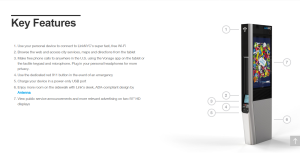Following public testimony on proposed rule, it was modified to require that new kiosks in residential historic district go before Landmarks for review, and increased the distance from which a kiosk replacing a pay phone may be sited near another public communications structure. On June 28, 2016, the Landmarks Preservation Commission voted to adopt modifications to existing rules regarding pay phones to account for a Mayoral plan to replace all pay phones with new public communications structures. The new kiosks will provide phone service and free Wi-Fi access, and ability to contact emergency services in an initiative named LinkNYC. The aluminum-clad kiosks will also possess stations for charging one’s phone and an interactive tablet. The rectangular, eleven-inch-wide kiosks will have a smaller footprint than pay phones, but will be taller, with those displaying advertising over ten feet high.
The kiosks are intended to be self-funded, offsetting costs through advertising on digital panels on the structures. Images on the digital display will transition every 15 seconds. After the City issued a request for proposals, the franchise agreement was awarded to Citybridge, a consortium of technology and telecommunications firms.
The design of the planned kiosks was reviewed and approved by the Public Design Commission. Approximately 7,500 kiosks are ultimately planned for installation throughout the City.
Landmarks considered public testimony on the proposed rule amendments at a hearing in May. Testimony largely objected to the advertising content and the brightness of the digital displays. The prominence of the kiosks in the streetscape and the design structures also came under criticism. A representative of Carnegie Hill Neighbors lamented that the design process did not include public input or community board approval.
Landmarks’ Counsel Mark Silberman presented the proposed rules and modifications made in light of public testimony at the June meeting. Silberman stated that the digital panels will be smaller than the advertising panels currently on the sides of payphones. The design of the kisoks, approved by the Public Design Commission, is binding, and outside of Landmarks’ power to change. He noted that the content of the screens is governed by the franchise agreement, and also outside Landmarks’ jurisdiction. Furthermore, the advertising is distributed Citywide through one point, and display different messages in historic districts would be technically and logistically difficult.
Two modifications to the rule changes were introduced as a result of the public testimony and commissioner comments. New kiosks, not replacing public pay phones, in residential historic districts must be reviewed by the Landmarks before installation. The siting requirements were also modified so that a new kiosk replacing a pay phone may not be sited within 100 feet of another public communications structure, rather than the 50 feet originally considered.
Silberman further stated that Citybridge had agreed to dim the advertising panels at night, and the agreement will be enforced by the Department of Information Technology and Telecommunications.
Commissioners voted unanimously to adopt the modified rules.
LPC: Proposed Citywide Rule, §2-21 (June 28, 2016).
By: Jesse Denno (Jesse is a full-time staff writer at the Center for NYC Law)


